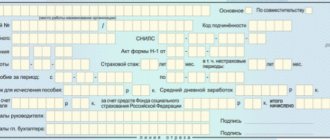Legal basis of non-cash payments in the Russian Federation
The procedure for non-cash payments is established by the Central Bank of the Russian Federation. The Regulations on the Rules for Transferring Funds, approved by the Bank of Russia on June 19, 2012 No. 383-P, provides for the following forms of settlements through bank accounts:
- payment orders;
- by letter of credit;
- collection orders;
- checks;
- transfer at the request of the recipient of funds;
- in the form of electronic money transfer.
Payment order is the most commonly used form for transferring funds for non-cash payments. When making payments by payment orders, the payer's bank undertakes, upon his order, to transfer funds to the recipient person indicated in the document.
A payment order can be drawn up and accepted for execution both on paper and electronically. If the document is drawn up in paper form, then the payer must provide four copies to the bank: one remains with the bank, one is returned to the client, and the other two are transferred to the recipient's bank. Currently, almost all mutual settlements on payment orders are carried out electronically through electronic banking systems (Internet banking, client-bank).
The payment order can be submitted to the bank within 10 calendar days from the day following the day of its preparation.
Do I need to change my TIN when changing my place of residence or surname?
When moving to a new place of residence in the territory under the jurisdiction of another tax authority, or changing the last name, first name, patronymic, the Certificate of registration of an individual with the tax authority at the place of residence must be replaced, since there has been a change in the data specified in it, i.e. The form of the certificate changes, not the taxpayer identification number.
It must be kept in mind that:
- There is no obligation for an individual to provide any information in connection with a change of place of residence, because deregistration of an individual is carried out by the tax office, with which the taxpayer was registered within 5 days from the date of receipt of information about the fact of registration from the passport office, and registration with the tax office at the new place of residence is carried out on the basis of documents received from the tax office authority at the taxpayer’s previous place of residence (clause 4 of Article 84 of the Tax Code of the Russian Federation).
- But this does not mean that nothing needs to be done - it is necessary to replace the certificate of registration of an individual with the tax authority at the place of residence and it is better to do this in advance. For example, when submitting documents to receive a tax deduction to the tax office at your new place of residence, the tax inspector will ask you to replace the TIN certificate.
To replace the certificate, you need to contact the tax office of the area to which you are moving. For this you will need:
- statement;
- identification document;
- a document confirming registration at the place of residence at the new address;
- certificate of marriage or divorce, certificate of change of name, etc.;
- Certificate of registration at the previous address - for citizens who are not individual entrepreneurs, or a copy of the Certificate of registration with a note from the tax authority at the previous place of residence about deregistration - for individual entrepreneurs.
When replacing the certificate of registration of an individual with the tax authority at the place of residence (TIN certificate form - Form No. 2-1 Accounting), the taxpayer identification number itself remains the same.
The article was written and posted on November 7, 2012. Added - 07/23/2013, 03/06/2015, 04/20/2015, 11/02/2017, 08/30/2018
ATTENTION!
Copying the article without providing a direct link is prohibited. Changes to the article are possible only with the permission of the author.
Author: lawyer and tax consultant Alexander Shmelev © 2001 — 2020
Form and rules of settlements for payment orders
The form of the payment order was approved by the Bank of Russia in Regulation 383-P dated June 19, 2012. It is unified, that is, it is used by all persons in this form; changes are not allowed.
Payment order form (form)
Payment details are information about the person to whom or to whose address the funds are transferred. These include:
- name of company;
- TIN;
- current account number;
- name of the servicing bank;
- correspondent account;
- BIC.
The absence of any of them will lead to problems with transferring money to the recipient. Payments to suppliers for goods and services are usually made on the basis of an invoice. It is therefore very important that your billing details are complete and free of errors.
Main bank codes
Large banks have their branches in different regions. Each regional branch has its own checkpoint. Sberbank branch codes:
- Moskovskoe - 773643001;
- North-West - 784243001;
- South-West - 616143001;
- Siberian - 540602001;
- Far Eastern - 272143001;
- Povolzhskoe - 631602001;
- Srednerusskoye - 775002002;
- Baikalskoe - 380843001;
- Volgo-Vyatskoe - 526002001;
- Uralskoe - 667102008.
VTB Bank branch codes:
- Moskovskoe - 770943002;
- St. Petersburg - 783543011;
- Ekaterinburgskoe - 665843003;
- Yuzhno-Sakhalinskoye - 650143001;
- Novosibirsk - 540643001;
- Nizhne Novgorod - 526043001;
- Stavropolskoe - 263443001;
- Rostov-on-Don - 616443001.
Details in corporate documentation
It is worth noting that there are different ways of specifying information in contracts. The details are mandatory; if they are not specified, the document will be invalid. Different types of documents require different data, but some of them are required in any case:
- telephone, email;
- reason code and TIN;
- details of the bank that services the organization;
- legal address.
IMPORTANT. The code is always issued at the same time as the TIN. In most cases, these combinations are written on one line separated by a slash.
How to fill in payment order details
Each payment order detail (corresponding field) has its own code.
The rules for filling out payment order details are established by the same Bank of Russia Regulation 383-P in Appendix 1. Our table will help you fill out the basic details correctly:
| Props number | Props name | Specified value |
| 3 | № | Payment order number: indicated in numbers. Numbering, as a rule, is continuous, consistent throughout the year. |
| 4 | date | Specified in the format DD.MM.YYYY. For example: 01/10/2019. |
| 5 | Payment type | Subject to credit approval guidelines. May have meanings: urgently, by telegraph, by mail, electronically. |
| 6 | Suma in cuirsive | Indicated with a capital letter. In this case, the amount of rubles is indicated entirely in words, and kopecks - in numbers. The words “ruble” and “kopeck” are indicated in the appropriate case and are not abbreviated. For example: one thousand five hundred rubles 50 kopecks. |
| 7 | Sum | The payment amount is indicated in numbers. Rubles and kopecks are separated by the symbol “-”: 1500-50 |
| 8 | Payer | Indicated:
|
| 60 | TIN | The payer's TIN and KPP are indicated in accordance with the registration documents with the tax authority. |
| 102 | checkpoint | |
| 9 | Payer account number | Bank details of the payer. |
| 10 | Payer's bank | |
| 11 | BIC | |
| 12 | Correspondent bank account | |
| 13 | Recipient's account number | Recipient's bank details. |
| 14 | payee's bank | |
| 15 | BIC | |
| 17 | Correspondent bank account | |
| 16 | Recipient | Indicated:
|
| 18 | Type of operation | 01 is indicated. |
| 21 | Payment order | Indicated by a number in accordance with federal law (Article 855 of the Civil Code of the Russian Federation). |
| 24 | Purpose of payment | Name of goods, works, services; number and date of the contract, trade documents, other information established by the rules of the organization, bank or legislation. For example, the rate and amount of VAT must be indicated. |
| 44 | Signatures | Relevant when drawing up payment orders on paper. Signatures must be identical to those indicated on the signature card. |
| 46 | Print location | Relevant when drawing up payment orders on paper. The seal impression must match the one indicated on the signature card. |
IMPORTANT!
From June 1, 2020, by the instructions of the Central Bank of Russia No. 5286-U, mandatory codes have been introduced that are indicated when issuing payment orders to individuals.
Read more: How to fill out a payment form for the transfer of alimony from June 1, 2020
Sample filling
Does the IP have a code?
According to the law, a reason code can only be assigned to an organization; an individual entrepreneur does not have one, and it cannot be assigned to him. If it happened that during the conclusion of the contract, among all the information you noticed a checkpoint, then this is information about the bank in which the entrepreneur has an account. An individual entrepreneur must indicate it, since when issuing a payment order, the individual entrepreneur is required to indicate the checkpoint of the recipient, in our situation, the recipient bank.
If it happens that when preparing documents it is still unclear what the bank’s reason code is and where exactly it is located in the details, then the simplest solution is to ask your partner for help. He must have all the information about the credit institution in which his money is located.
There are several other options for solving this problem, for example, finding information about the bank using the TIN. This can be done using the Federal Tax Service website. You can also contact the bank directly, call the hotline, or find information on the bank’s official website, but this method will take the most time.
Features of registration of taxes and fees
The most common problem is filling out the details of orders for payments to the budget (transfer of taxes, fees and other mandatory transfers). Errors in such documents can lead to incorrect reflection in the taxpayer’s card to the Federal Tax Service.
In addition to the generally accepted details described above, fields 101–109 must be additionally filled in in tax transfers. The rules for filling them out are established by the Ministry of Finance (Order 107n dated November 12, 2013).
Details of payments to the budget
| Field | Name | The most common indicators |
| 101 | Payer status | 01 - payer legal entity 09 – individual entrepreneur 02 - tax agent 08 - other transfers to the budget (contributions from accidents to the Social Insurance Fund) |
| 102 | Payer checkpoint | |
| 103 | Recipient's checkpoint | Checkpoint of the authority to which the transfer is made |
| 104 | KBK | Budget classification code corresponding to the payment being paid |
| 105 | OKTMO | At the payer's location |
| 106 | Basis of payment | TP - transfer by deadline ZD - payment of debt voluntarily TR - debt on demand AP - transfer according to the inspection report |
| 107 | Payment period | For current transfers, it is indicated in the format depending on the frequency of payment:
To pay a debt - date of request 0 - in other cases |
| 108 | Document Number | Request or review decision number 0 - in other cases |
| 109 | Document date | Date of request or review decision 0 - in other cases |
What is a Taxpayer Identification Number and why is it needed?
The procedure and conditions for assigning, applying, and changing a taxpayer identification number are determined by Order of the Federal Tax Service of Russia dated June 29, 2012 No. ММВ-7-6/ [email protected] “On approval of the Procedure and conditions for assigning, applying, and changing a taxpayer identification number "(which came into force on September 2, 2012), as well as (partially) - Order of the Ministry of Taxes of Russia dated March 3, 2004 No. BG-3-09/178 “On approval of the procedure and conditions for assigning, applying, as well as changing the taxpayer identification number and forms of documents used for registration and deregistration of legal entities and individuals.”
There is no legal (legislative) definition of TIN. According to the Letter of the Federal Tax Service of the Russian Federation dated April 20, 2010 No. MN-37-6 / [email protected], the taxpayer identification number (TIN) is the personal number of each person in the tax authorities of the Russian Federation. It serves to record information about the income of a particular individual that is subject to taxation, and to record taxes paid, such as: land tax, property tax, income tax, etc.
For some reason, legal entities fell out of this concept, so it would be more correct, in my opinion, to say that a taxpayer identification number (TIN) is a digital code necessary for registering taxpayers with the tax authorities, which is assigned to each taxpayer.
The TIN is used by the tax authority as the registration file number of an organization or individual.
The tax authority indicates the taxpayer identification number assigned to the organization (individual) (for the organization - also the checkpoint) in all notifications sent, as well as in the certificate of registration with the tax authority and in the notice of registration with the tax authority.
Each taxpayer indicates his TIN in the declaration, report, application or other document submitted to the tax authority, as well as in other cases provided for by law.
Individuals who are not individual entrepreneurs (IP) have the right not to indicate the TIN in tax returns, applications or other documents submitted to the tax authorities, while indicating their personal data provided for in paragraph 1 of Article 84 of the Tax Code of the Russian Federation. If the TIN is indicated in the tax return, then (in particular) page 2 of the 3-NDFL tax return does not need to be filled out.
A taxpayer identification number may be required when applying for a job - after all, for an employee, his employer is a tax agent, which means that the organization in which the individual works is obliged to calculate and pay personal income tax to the budget for the employee, as well as contributions to extra-budgetary funds.
The TIN must be indicated to use the services of the Unified Portal of State and Municipal Services.
TIN of the organization
In connection with the creation of a new organization for its registration with the tax authorities, when registering it with the tax authority at the location of the Russian organization (registration), it is assigned a conditional number - TIN.
A taxpayer identification number has been assigned to legal entities since 1993, and to individual entrepreneurs since 1997.
TIN structure of a legal entity:
The organization's TIN consists of 10 digits: NNNNXXXXX C
Where:
- NNNN - for Russian organizations and individuals - the code of the tax authority that assigned the TIN, of which:
1 - 2 characters - code of the subject of the Russian Federation;
- 3 - 4 characters - code of the tax inspectorate of the constituent entity of the Russian Federation;
You can check your TIN using the following algorithm:
- We find the products of the first 9 digits of the Taxpayer Identification Number (TIN) by special factors, respectively. 9 multipliers (2 4 10 3 5 9 4 6 8).
- We add up all 9 resulting products.
- We divide the resulting amount by the number 11 and extract the integer part of the quotient from the division.
- Multiply the resulting number by 11.
- We compare the numbers obtained in step 2 and step 4, their difference is the control number, which should be equal to the 10th digit in the TIN (if the control number turns out to be equal to 10, in this case we take the control number equal to 0).
KPP reason code for registration
For organizations, in addition to the TIN, in connection with registration with the tax authorities, a registration reason code (hereinafter referred to as KPP) .
The checkpoint is assigned to a Russian organization upon registration (recording of information) with the tax authority:
- At its location simultaneously with the assignment of a TIN;
- At a new location - when the location of an organization changes if its new location is located in the territory under the jurisdiction of another tax authority;
- At the location of each of its separate divisions (including in the tax authority selected by the organization in the prescribed manner for each of its separate divisions);
- At the new location of its separate division - when the location of a separate division of the organization changes if its new location is located in the territory under the jurisdiction of another tax authority;
- At the location of the real estate and (or) vehicles owned by it;
- On other grounds provided for by the Tax Code of the Russian Federation.
Checkpoint structure
The reason code is a nine-digit code: NNNN P P XXX
Where:
- NNNN (1 - 4 characters) - code of the tax authority that registered the organization at its location;
- R R (5 - 6 characters) - reason for registration (recording of information);
- XXX (7 - 9 characters) - serial number of registration (registration of information) with the tax authority on the appropriate basis.
How to fill out the order of payment in a payment order
The order in which funds are written off is regulated by Article 855 of the Civil Code of the Russian Federation. When filling out payment orders, the order of payment is indicated in the form of the appropriate code:
| Code | Type of transfer |
| 1 | According to enforcement documents: compensation for harm caused to life or health, claims for alimony |
| 2 | According to executive documents: arrears of wages, severance pay |
| 3 | Wage |
| 4 | According to executive documents providing for the satisfaction of other requirements |
| 5 | All other payments: transfers to suppliers, payment of current taxes and fees, etc. |
Errors in payment documents
If an error is found in the payment details, it must be corrected as appropriate. When the counterparty details are filled in incorrectly, you can:
- send clarification of the details in the payment order to the bank in writing;
- wait for the money to be returned to your bank account and re-issue the payment.
If a clerical error or inaccuracy is found in the purpose of the payment, then a letter of clarification should be sent to the counterparty, since this error will not lead to non-crediting of money to his current account, but may lead to incorrect reflection of settlements in the accounting records of the counterparty.
Let's look at how to correct errors found in a tax payment. They can be critical (that is, the money will not go to the budget) or non-critical (if the payment did go to the budget, but will be reflected incorrectly).
| Error | Solution |
| Critical errors | |
| The recipient's bank is incorrectly specified |
|
| The recipient's account number is incorrect | |
| Non-critical errors | |
| Errors in fields 101–109 |
|
How to find out the checkpoint?
If you wish, you can find out not only your registration code, but also the checkpoint of any other legal entity. To do this, you only need to have the organization’s TIN, but more often than not, even this is not required - just the organization’s website or at least its name. A regular search on Google or on the Federal Tax Service website will quickly lead to results.
The fact is that most legal entities do not intend to hide and hide. On the contrary, details are often available literally on the main pages of the official websites of various organizations. You just need to search carefully.
If you need an exact algorithm for viewing the checkpoint, it starts from the Federal Tax Service website:
- Go to the website https://www.nalog.ru ;
- Find the tab “Business risks: check yourself and your counterparty” and click on it;
- Indicate the TIN of the organization;
- Click the "Find" button;
- All the information you are interested in about the organization will appear in a new window, including its checkpoint and other details.
In this way, you can restore knowledge about your own company if for some reason access to documents was lost. The main thing in such a situation is to remember at least the TIN of the company.










